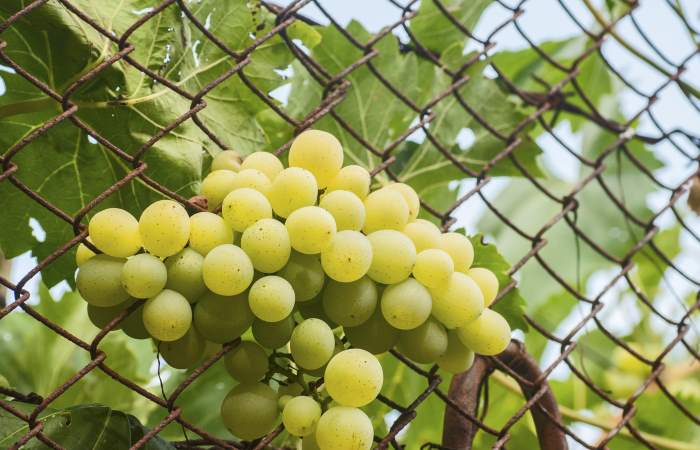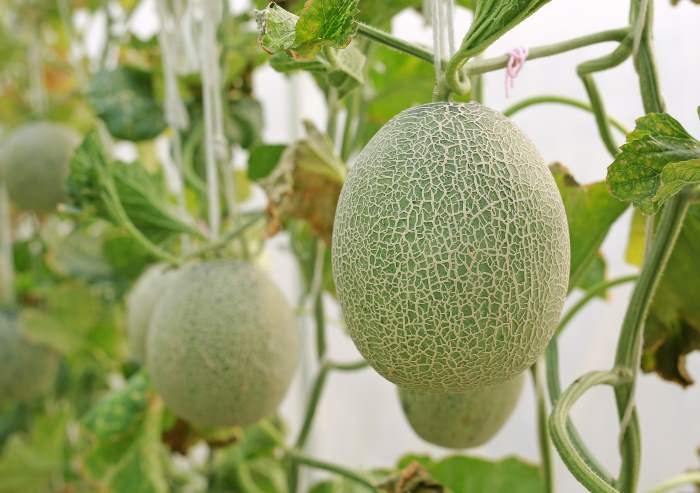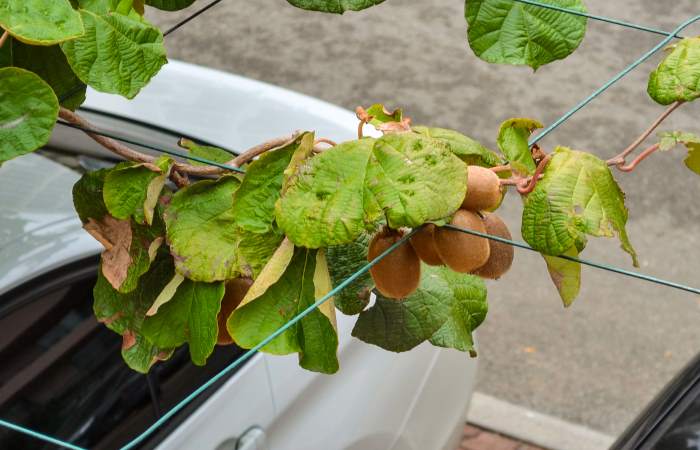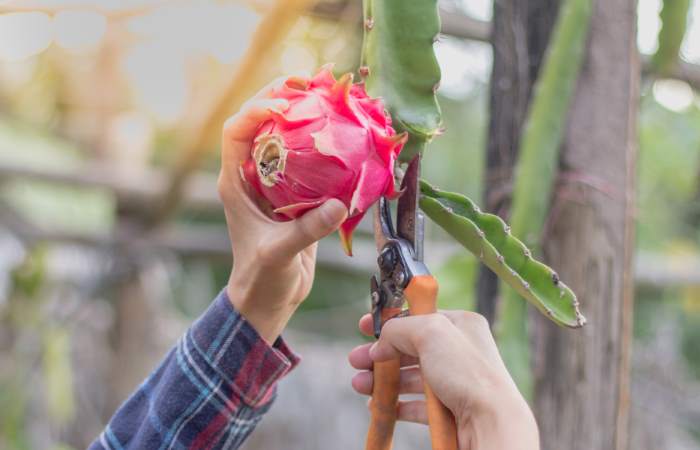With urban and suburban gardening growing in popularity, many people living in smaller spaces are wondering how they can grow their own delicious fruit right at home. This is where vining plants come in!
Several fruits grow on vines, which allow prospective growers to utilize their horizontal space to maximize their growing area.

Whether you have ample growing space outside your house or are limited to a few trellises inside your apartment, growing vining fruit allows you to enjoy the experience of cultivating and harvesting your own fresh fruit right at home.
There are even many perennial options that will produce fruit year after year if you’re looking to implement a permaculture approach to your garden.
So the next time you’re wondering what to plant in your space, consider one of the following five best vining fruit.
Melons
Melons are some of the most popular vining fruit for home gardeners to grow and for good reason! There are more than 30 varieties of melons, all members of the Cucurbitaceae family, varying in size, color, and flavor.

Some of the most commonly grown melons include watermelon, honeydew, and cantaloupe.
There are many exotic varieties you can try your hand at growing too, like casaba, gac melon or the extremely expensive Yubari King melon, which can cost upwards of $20,000 each.
Melons produce sprawling vines that can easily take over a garden plot, so they’re best grown upward on trellises. It’s easy to train melon vines to grow upward, but some varieties of melons can get too heavy for vertical gardens.
It’s better to choose smaller varieties of melons if looking to grow them upward instead of on the ground. Even smaller varieties of melons should be supported with a sling to keep them from falling.
If you’re looking for a small and unique melon to grow this year, consider adding cucamelons to your garden lineup. Native to Central America, cucamelons look like tiny watermelons and are about the size of a grape when harvested. It has a tangy, lemony flavor and is very prolific. The small size of the vines makes them ideal for indoor or container gardening.
Grapes

With over 60 different species and over 8,000 varieties of grapes, there’s sure to be one that you’ll enjoy growing in your garden. Grapes are a worldwide favorite, and there’s more agricultural land devoted to growing grapes than anything else!
These vining perennials can be grown across most of the United States, although some varieties do best in a more limited range.
Vines can grow up to 50 feet in length, although they can be pruned to stay small. Miniature grape varieties that grow well in containers and only grow a few feet tall, such as the Pixie, are also available.
Grapes require regular pruning and care, as fruit only develop on new growth. But it’s not hard to learn to take care of your grape plant, and well worth the effort. Plants can develop up to 40 clusters of about 75 grapes each, so a well cared for plant can produce more than enough fruit for your family.
A grapevine will grow for over 120 years too, making it one of the best perennial fruit vines you can invest in.
Kiwi
Kiwifruit (Actinidia deliciosa) is a great option for gardeners living in temperate climates with short winters and long growing seasons. It is more challenging to grow than other vining plants as it requires lots of space to grow.

While it can be trellised upwards, it also needs horizontal space to grow as its vines can extend over 30 feet in a single year! They do best if allowed to grow on a sturdy pergola.
They are not self-producing, either, and will require one male plant and eight or nine female plants to produce their small, fuzzy fruit. Plants will also require regular pruning to produce fruit, as kiwis only grow from new growth on old wood.
If you live in a colder climate, you can opt to grow hardy kiwi (Actinidia arguta) instead.
It still requires the same care as regular kiwifruit, but can thrive in hardiness zones 4 to 9 and only grows around 12 feet each year. Hardy kiwi is also much smaller than kiwifruit, growing only to the size of a grape but making up for their size with prolific fruit production.
It can take anywhere from three to seven years before kiwi plants begin to produce fruit, but if you’re willing to put in the time and effort to grow these delicious plants, you’ll be richly rewarded. Each female vine can produce hundreds of pounds of fruit and beautiful, aromatic flowers and an established vine can live for 50 years or more.
Passion Fruit
Passiflora edulis is a perennial species of passion flower that produces a delicious and colorful berry.

Native to Brazil, most varieties will only do well in very warm areas of the US, like Florida, California or Hawaii.
Passiflora incarnata, or Maypop, is a cold-hardy passion fruit native to North America that can be grown across most of the southern United States and also produces a tasty berry.
Both species of passion fruit are prolific growers that can produce 10 to 20 fruit per vine. Each vine can grow up to 15 feet in height and should be trellised to control its growth. Otherwise, it can spread to unwanted areas and can be hard to control. It is even considered an agricultural weed in some areas.
Passionfruit vines also produce beautiful and unique flowers which help attract all kinds of pollinators, from bees to hummingbirds. Passionflowers are known to be a favorite of the ruby-throated hummingbird.
You can expect fruit, and a lot of it, around 80 days from when they bloom. Passionfruit vines will live around five to seven years, but will easy spread new growth to surrounding areas. You can easily grow either species in containers, and cut them back and bring them in during the winter.
Dragonfruit

Dragon fruit (Hylocereus undatus) is a tropical perennial climbing cactus that produces spiny red or white fruit on long vines. Its aerial roots climb up trees or other supports and produce fleshy and delicious 2-pound fruit.
Being a tropical fruit, it only does well in USDA Hardiness Zones 10 and 11, but if you can grow it, you definitely should. It is a long-lived perennial that grows over 40 feet tall and produces fruit for 20 to 30 years.
Another option is to grow dragon fruit indoors. Dragon fruit responds well to pruning and will stay small and compact and will still produce fruit for you if given the right care.
Being a cactus, dragon fruit needs it hot, like around 100 degrees Fahrenheit. A heat lamp can provide your indoor dragon fruit with all the heat it needs. Dragon fruit likes moist soil but is susceptible to root rot if overwatered.
In Summary
Choosing to add vining fruit to your garden is a wonderful way to maximize your grow space and enjoy the sweet and refreshing fruits of your labor.
There are many options of fruit vines to choose from, ensuring that everyone can grow fresh fruit at home, no matter how small their space. If you’re looking to start growing your own food at home, a fruit vine is a great place to start.
Best of all, many fruit vines are perennials, so you’ll get fruit harvests year after year as long as you take good care of your plant. So what are you waiting for? It’s time to get growing!










